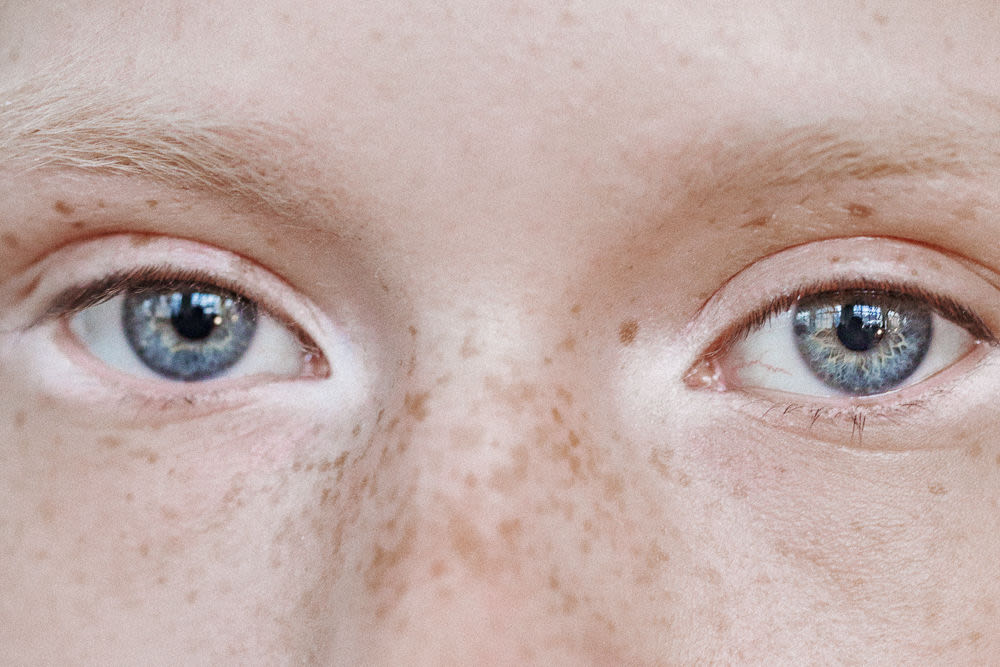You’ve got a lot of questions about your undereyes. In fact, it’s probably the most asked about topic across our social platforms. Which is why I’m not here to discuss whether eye cream does anything (it does) what it’s supposed to be doing (a lot) or if you should be using it (you probably should). I’m here to provide answers. The truth is, if you’re using the wrong cream for your specific undereye concerns, of course it’s not going to work! And all eye creams still come with limits—that’s where a visit to your friendly neighborhood medical professional comes in.
To assuage your confusion, here’s a handy guide built with the help of dermatologist Dr. Morgan Rabach and plastic surgeon Dr. Lesley Rabach of LM Medical (called Dr. M and Dr. L, respectively, from here on out to avoid confusion). Behold! Everything you could ever possibly want to know about treating that finicky inch of skin below your eyeballs. Scroll to your particular concern, take a screenshot, and send this page to anyone audibly wondering, “What the heck can I do for my undereyes?” Your perfect undereye solution exists, and it’s right here.
First: A Note On Milia
Popular wisdom will tell you that using an eye cream puts you at risk for developing small white bumps under your eyes called milia. In reality, that’s only half true. They can be caused by a clogged sweat duct or hair follicle, but they can also be triggered by just about anything—certain skin disorders, trauma, allergic reactions, some topical drugs, and nothing specific at all (called spontaneous milia). They’re also pretty common on newborns. The most important thing to know about milia is that they won’t pop—if you have milia that doesn’t go away on its own (it might!) a dermatologist can remove them for you. And if you’re still worried about milia, just avoid using extremely effective occlusive ingredients like petrolatum under your eyes.
Fine Lines
What They Are:
You’re here because you’ve started noticing tiny wrinkles around your eyes. “Fine lines happen from sun damage as well as volume loss,” says Dr. L, which means they’re basically inevitable. Most treatments for fine lines are preventative as well as repairative: if you don’t think much about your undereyes (they’re not particularly puffy or dark), I’m talking to you, too.
How To Treat Them:
At home:
One way to do it is plumping through hydration. “The skin under the eye is some of the thinnest and most delicate on the face,” says Dr. M. “Undereye creams that contain hyaluronic acid are particularly helpful with hydration.” Deeply nourishing ingredients like ceramides and avocado oil help, too. You can use them morning and night.
You can also start to incorporate an eye cream with retinol. “Retinols help activate collagen production,” says Dr. M, which makes skin thicker and less prone to wrinkles. As a bonus, retinol eye creams can also make dark circles a little less visible—it’s not instant, but it will help over time. You can always use the retinol you use on your face under your eyes, but eye-friendly formulations are a bit gentler to account for the more fragile skin. As with all retinols, use only at night and work up to every day slowly to avoid irritation.
With your doctor:
You can stimulate collagen for tighter skin by creating microscopic injuries in the skin. “Co2 laser and microneedling can help reduce fine lines.”
And then there’s the injectable route: Botox, fillers, or a combination of both. “Super small amounts of Botox can help reduce fine lines,” says Dr. M, “while filler can plump them up.” And Dr. L adds, “If the lines are more extensive, I often remove a little bit of skin for smooth, youthful results.”
Dark Circles
What They Are:
You’re here because your main concern is dark circles. Remember how your undereye skin is particularly thin? “Veins in that area are also much smaller and finer,” explains Dr. M, adding, “they almost form a web of lace under the thin skin.” While lacy undereyes sound pretty, it’s the combination of thin skin and lots of little veins that give the skin under your eyes a blueish tint. “You’re actually able to see the tiny little blood vessels through it,” Dr. L confirms.
Your skin naturally thins as you age (thanks, decrease in natural collagen and elastin production!) which is why your undereyes might look darker over time. But your dark circles might also just be genetic. “Some people have them as a child,” says Dr. M. If you have a hunch yours might be a thoughtful gift from your elders, she suggests looking at your family members and considering when your dark circles first became visible. Determining if your dark circles are genetic or situational changes how you treat them, so it’s an important place to start.
How To Treat Them:
At home:
“A permanent solution to dark circles is tough,” says Dr. M. “Undereye creams will improve the skin's health but will never make dark circles disappear 100-percent.” Because you can’t really get rid of them, an instant fix is your best bet. Daytime eye cream with a peachy tint will help mitigate some of that darkness instantly—think of them as skincare color correctors. Any of the following eye creams would work for you, but the best one to choose depends on the exact kind of dark circles you’re dealing with.
Let’s say you only notice darkness under your eyes when you’ve skimped out on your recommended nine hours of sleep. That’s because a lack of sleep causes your blood vessels to dilate—bigger veins means they’ll be more visible. Caffeine will constrict blood vessels and help decrease darkness. Peachy eye creams with tightening caffeine as a hero ingredient are also good options for those with genetic dark circles and some puffiness.
If you’re a person of color, you’re more likely to have undereye hyperpigmentation—that’s when the actual skin under your eyes appears darker, not translucent. In that case, look for a peachy eye cream that also has brightening agents to work instantly and over time to even skin tone.
If you’ve got genetic dark circles and are concerned with fine lines, look for something tinted with deeply nourishing, hydrating ingredients. Bonus points if it also has SPF—daily protection from the sun ultimately prevents damage that makes skin thinner, more translucent, and prone to fine lines.
Microcurrent might also help with dark circles. Here’s one writer’s before and after experience: This Is My Face On NuFace
Or if you’re interested in trying a more low-tech approach, you can also try a DIY brightening face mask. One with turmeric helps conceal dark circles by leaving a peachy stain on skin. Here’s how to do it: The DIY Undereye Brightening Mask
With your doctor:
Looking for a more permanent solution than tinted goop? That requires a trip to your dermatologist. “Injectable hyaluronic acid is a very effective way of treating dark hollows under the eye,” says Dr. M. “Hyaluronic acid is placed underneath the skin with a blunt tube called a cannula,” she explains. “The hyaluronic acid replaces the fat and collagen that we naturally lose in this area over time. Blood vessels blanketed by filler are further from the surface of the skin, making the undereye area seem less dark and hollow.” Dr. M advises that undereye filler, also known as tear-trough filler, generally lasts from one to three years and can cost anywhere between $1,000 and $3,000, depending on where you go. And the risks are minimal: the most common side effect is bruising in the area, which is easily coverable and dissipates on its own within two weeks.
Puffiness
What It Is:
You’re here because you just want the puffiness under your eyes to go down. “Puffiness is excess fluid in the tissue under the skin,” says Dr. M. As with dark circles, puffiness under the eyes can be caused by lots of different things—and knowing your cause is necessary for finding a treatment that works. “It can happen from lack of sleep or dietary factors like salt,” which are the most easily treatable causes, “but allergies can also cause edema,” the medical term for swelling, “in the undereye tissue.” The hardest form of puffiness to treat is, of course, outside of our control. “As we age,” explains Dr. L, “we lose fat on the orbital rim and some of us develop a herniation, creating a bulge followed by a trough.” Not only does this cause undereye puffiness that never seems to go away, but the shadow made by that bulge can also contribute to the look of dark circles.
How To Treat It:
At home:
For a topical fix, Dr. M recommends something with caffeine as its main ingredient. “Caffeine helps shrink blood vessels,” she explains, which decreases inflammation and provides a temporary tightening effect.
Another ingredient that might help with undereye puffiness is vitamin K. (There aren’t a ton of studies that have looked at it, but this one seems promising.) The hype surrounds vitamin K’s ability to improve circulation—better circulation means fluid isn’t sitting stagnant under your eyes.
Looking for an instant improvement? Try gently pressing something cold on your undereye bags. The trick works well no matter what you use (as long as you’ve kept it chilled) but we have some favorites.
Want more suggestions? You got it: Bye Bye, Bags Under Eyes and How To Depuff Your Eyes This Morning
With your doctor:
The only way to get rid of genetic eye bags? Don’t freak out—the answer is surgery, but it’s a relatively easy one. “A lower blepharoplasty is an in-office surgical procedure to remove periorbital fat that creates a bulge,” says Dr. L. She prefers to perform the procedure using a “transconjunctival approach,” which means the incision is hidden inside the eye. The fat is removed (or sometimes repositioned) and your eye shape won’t change. “I perform this procedure in my office multiple times a week, under local anesthesia. The best part is there are no incisions on the skin and no stitches—you’ll have some swelling and a variable amount of bruising, but that can be covered with concealer immediately.” Dr. L quotes the cost to be somewhere between $6,00 and $8,000, depending on your individual case. But with a high price comes good news: the results are permanent.
And How To Cover Them Up
“I always like having a little bit of dark under the eye,” said Christopher Niquet in his Top Shelf, and I have to agree there’s something sexy about ‘em. But if you’re looking to brighten up dark circles, the best way is to color correct.
If you have deep or olive skin, a good place to start is YouTuber Deepica Mutyala’s viral color correcting video—she uses lipstick, because an undereye corrector for deeper skin tones didn’t really exist at the time. It worked so well that she actually developed her own product. “It took years after my video went viral to create the perfect formula to work as a color corrector. Now I'm obsessed.” Reds and oranges cancel out your green and blue tones.
And lighter complexions can reach for a peachy corrective concealer. Apply just under your eyes—because it’s slightly too warm to match the rest of your skin, a product like this won’t help to cover zits.
After blending to correct, follow with your favorite foundation or concealer. If you’re looking for recommendations, here are 10 makeup artists’ opinions on the matter: The Best Undereye Concealers, According To The Pros
And here’s the technique: How To Get Rid Of Dark Circles Under Your Eyes
Phew—that’s everything! Which undereye treatment worked the best for you? Let’s meet in the comments.
—Ali Oshinsky
Photo via ITG

